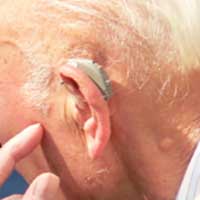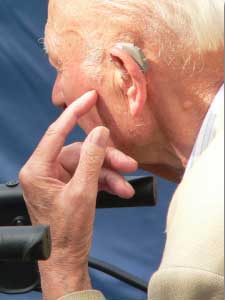Completion requirements
View
Topic Overview

- Hearing loss is very common among older people, affecting 50% of those over the age of 60.
- There are several different kinds of hearing loss.
- Hearing loss should be identified and treated. If left untreated it can lead to a variety of problems including social isolation, depression, and relationship difficulties, among others.
- Hearing aids and other amplifying devices can be helpful for people with hearing loss.
- Basic communication strategies can be used to improve understanding when talking to someone with hearing loss.
Introduction

- As people grow older, they are more likely to have hearing difficulties. In fact, hearing loss affects one out of two Canadians over the age of 60 years. It is the third most common chronic condition among older adults, after arthritis and hypertension.
- It is important to identify and treat hearing loss, as it can affect mental processes, and can lead to depression, social withdrawal, difficulties in interpersonal relationships, and reduced functioning.
What You Need to Know
Signs of a Hearing Problem
 A person with hearing loss may show the following signs:
A person with hearing loss may show the following signs:
- difficulty understanding words
- asks you to repeat often
- less participation in or avoiding conversations
- increased volume on the television or radio
- avoids answering the telephone
The presence of a hearing loss needs to be identified in order to determine an appropriate strategy or treatment. A hearing test can be completed by an Audiologist..
Types of Hearing Impairment
Normal hearing involves the conversion of sound into electrical impulses, which are then processed by the brain. A hearing impairment results from an abnormality in one or more parts of the auditory system.
- Conductive hearing loss: when sound is not conducted efficiently to the inner ear. This typically involves a problem in the outer ear canal, eardrum or the tiny bones of the middle ear. Some causes of conductive hearing loss may be permanent, while others are able to be corrected medically or surgically.
- Sensorineural hearing loss: when there is damage to the inner ear or auditory nerve pathways from the inner ear to brain. This type of hearing loss is permanent. Hearing aids and other amplification devices can often help individuals with this type of hearing loss.
- Central hearing loss: when there is a problem in the central nervous system, and not the ear itself. This means that although an individual can hear the sound, their brain has a difficult time understanding and processing the sound.
- Mixed hearing loss: when a conductive hearing loss is present in combination with a sensorineural hearing loss.
Causes of Hearing Loss
Causes of conductive hearing loss may include:
- wax build-up
- ear infection (otitis media) or fluid in the middle ear
- eustachian tube dysfunction
- perforated eardrum
- arthritis of the bones in the ear
- medications (diuretics, certain antibiotics, anti-inflammatory medications)
- Absence or malformation of the outer ear, ear canal, or middle ear
 Causes of sensorineural hearing loss may include:
Causes of sensorineural hearing loss may include:
- aging (called presbycusis)
- genetics (hearing loss that runs in the family)
- extended exposure to loud noises
- metabolic disease (hypothyroidism, renal failure), Paget's disease
- head trauma, blood vessel problems, brain tumors, stroke
- infections
- drugs that are toxic to hearing
Hearing Loss – Evaluation and Strategies
Evaluation of Hearing Loss
- A request for a hearing assessment may be made through a medical doctor or through self referral by contacting an audiology clinic within the community.
- An audiologist is a healthcare professional who specializes in the identification, diagnosis, treatment and management of auditory and vestibular disorders. A hearing instrument practitioner provides services for the testing, selection and fitting of hearing aids.
- Audiologists and hearing instrument pracitioners are both trained to conduct hearing tests and fit hearing aids. The difference between an audiologist and hearing instrument practitioner is the level of education received. An audiologist holds a Masters degree from a university (6 years of post-secondary education) and a hearing instrument practitioner receives training through a college program (2 years of post-secondary education).
- Prior to a hearing test, the ears will be examined for wax, foreign bodies, perforation of the eardrum, and fluid in the middle ear. These can sometimes lead to a temporary hearing loss. If any of these are present then there may be a referral to a medical doctor to manage.
- If a permanent hearing loss is identified then there may be a need for amplification. The audiologist or hearing instrument practitioner can discuss hearing aid and assistive listening devices.
Hearing Aids and Assistive Listening Devices

- A hearing aid is device that amplifies sounds. A hearing aid is worn to help improve sound awareness and increase speech intelligibility for the user.
- Hearing aids are equipped with a microphone, receiver, amplifier, battery, ear mould, and volume control.
- If hearing loss is present in both ears then wearing bilateral hearing aids will help to improve the understanding of speech in crowded environments and provide the directional clues to localize sound.
- Other assistive listening devices (ALDs) available include amplified telephones, television amplifiers and transmitters, visual doorbells, alarm clocks, and fire alarm alerts.
- Cochlear implants are surgically implanted electronic devices that can provide sound to individuals who are profoundly deaf or severely hard of hearing. Candidacy for cochlear implants can be discussed with a medical doctor or an audiologist.
Communicating with Someone with Hearing Loss
Here are some basic strategies to use when speaking to someone with hearing loss:
- Ask what is the best way to communicate with them.
- Face them and ensure you have their attention.
- Speak clearly and distinctly.
- Do not shout.
- Provide a quiet environment.
- Provide good lighting on the speaker's face.
- Use gestures and facial expressions to get the message across.
- Change wording rather than repeating a message.
- Ensure hearing aids are in place and working.
- Have the listener repeat back what they heard to ensure your message was understood correctly.
Resources
- The Society provides services that enhance the independence of people with hearing loss or those who are deaf and encourages prevention of hearing loss.
Last modified: Wednesday, 27 April 2022, 9:22 AM